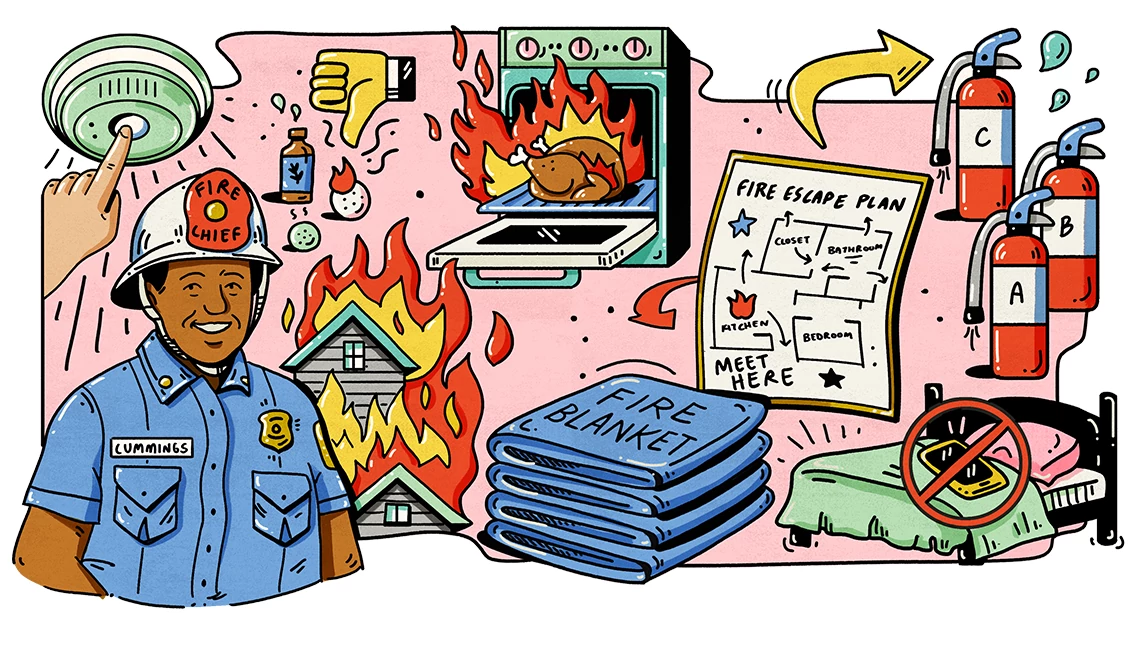AARP Hearing Center


House fires can affect anybody, but according to the U.S. Fire Administration, older adults are especially vulnerable. The rate of deaths from fire for the general population increased by 22 percent between 2013 and 2022 (the latest data available), but for Americans 65 to 74, their chances of dying in a house fire increased by a whopping 45.4 percent over that period. All that said, you can mitigate your risk with just a few small lifestyle changes.
Former Los Angeles Fire Chief Brian Cummings, 66, has devoted his life to fire safety. The son of a 30-year firefighting vet, he joined the Los Angeles Fire Department a few days before his 21st birthday in February 1980. By 1993, he was a captain, and in 2011, he became the city’s fire chief. Since his retirement in 2014, he’s been a fire technical supervisor on TV shows, including ABC’s Station 19, and provided work environment training for hundreds of fire departments and thousands of firefighters across North America, offering both useful advice and professional standards training. Here are 12 suggestions that Cummings says could decrease your chances of being involved in a deadly house fire.
Keep essential oils out of the dryer
Wool dryer balls can help reduce static and drying time. And you’ve probably seen people on social media recommend adding essential oils to them so your laundry smells fresh. But essential oils are flammable and, together with the dry wool, can create the potential of a fire because most dryers on low heat run at around 125° F and 135° F on medium to high heat. It’s too risky.
Not all fire extinguishers are the same
When you buy a fire extinguisher, don’t pick the first one you find. There’s a rating system of numbers and letters. The number indicates how many "units" of fire the device will extinguish. The letters A, B, C, D and K indicate what type of fire it can be used on. Class A is used for ordinary combustibles: things like paper, wood, cloth, plastics and most solids that are not metals. The most basic Class A extinguishers use pressurized water. Class B extinguishers are meant for flammable liquids, something like a gasoline fire or a grease fire on your stove. Class C extinguishers are for electrical fires — anything that catches fire when it’s plugged in. Both Class B and C shoot either a white cloud of carbon dioxide, “snow.” or dry powder like bicarbonate of soda. You should absolutely not use a Class A extinguisher on your stove, because it may actually make the fire worse. Class Ds are for flammable metallic substances like potassium and sodium, and Class Ks are for putting out fires in industrial cooking appliances that use vegetable or cooking oil.
You can also get an ABC extinguisher, which can handle the first three scenarios (not flammable metals or big grease fires) with a dry chemical agent that basically chokes the fire of oxygen. In my home, I have a 5BC-rated extinguisher in the garage and by the grill, a 2A-rated one in the house, and a fire blanket in the kitchen. These are usually the best choices for most households.
Can’t figure out how to install a smoke alarm? Ask your local firefighter
I can’t speak for all local fire stations, but many large municipalities have free or reduced-price smoke detectors available for anybody in the community — just ask or go to their website. Some fire departments may even send someone to assist with installation. That can be a huge help, especially for older adults who may not want to climb a ladder and install a smoke alarm themselves.


































































You Might Also Like
Here’s What to Do With All Your Unwanted Stuff
We share advice on how to sell, donate and recycle after you declutter
25 Great Ways to Save on Monthly Bills
Lower your payments without sacrificing your lifestyle
How to Do the Heimlich Maneuver
These 5 steps could save a life